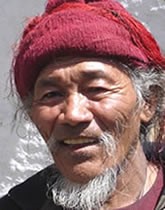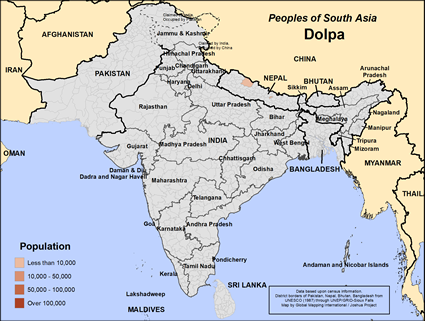A few thousand Dolpa people live in the Karnali Zone in north-west Nepal, all the way up to the border between Nepal and China. This has led some to speculate that the Dolpa may also be found inside Tibet. The Dolpa inhabit the villages of 'Goomatara, Kola, Tachel, Kani, Bajebara, Laun, Chilpara, Bantari and Byas ... beyond the mountains west of the upper Kali Gandaki River valley.... [The Dolpa] live in about 24 villages scattered over 500 sq. miles in Namgang, Panzgang, Tarap and Chharbung subdistricts.' Dolpa people also live within the Dhawalagiri Zone, west of the Loba people. The name Dolpa comes from Dolpa—the historical name for their area.There seems little doubt that the ancestors of the Dolpa originated in Tibet, before coming south in search of better pastures. They have been in Nepal now for many centuries, although they still retain many of their traditional customs and oral legends of their long migration. The Dolpa are regarded as the original inhabitants of their region.
Most Dolpa people these days have settled down in permanent villages, but some continue to lead a nomadic existence, travelling around with their herds ten months every year. Dolpa villages are situated between 3,660 and 4,720 meters (12,000 to 15,500 ft.) above sea level. 'The terrain is rather bare, with almost treeless grassland valleys, which take on a colorful luster in July and August with a carpet of bright alpine flowers. The rough stone houses of Dolpa are all clustered into a narrow space, making the villages look like forts. Some of them are probably among the highest human settlements in the world.' The Dolpa say it takes seven days to walk from one end of their region to the other.Severe winter temperatures have made the Dolpa a hardy people. Their houses are built with no windows at all, as every inch of insulation helps them survive the brutal weather. Ceilings are built low to the ground to retain warmth. Cattle and other animals are housed in the ground floor during the winter months.
Tibetan Buddhism and Bon exist harmoniously side by side among the Dolpa. Buddhist and Bon lamas often combine their duties. 'Not only do these lamas handle the religious works and celebrations of the community, but they also act as faith healers in times of sickness. Without the direction of the lama, these people neither perform any big ceremonies nor go on journeys, and in fact do not decide on anything at all. 'In the mid-1990s, a missionary organization noted, 'This group is totally untouched by the gospel. They still have no written language or Christian literature. There are no known Dolpa believers. In order for a church to be established within this people group, there must be a movement starting with the village leaders and working down from there. Because of their culture, it will do little good for a few individuals or young people to accept Christ.' Since that time a few Dolpa people from Dolpa are known to have started following Christ, but this group remains in great need of the gospel.
How will the Dolpas hear the gospel in such a remote area? As indicated earlier, there has been a tiny gospel outreach among them. It will take people who are willing to live at high altitudes with bitterly cold winters to reach them.
Pray that the hearts of the Dolpa people would be stirred to hunger after God, to drink of living water.Pray for family-based movements to Christ to transform Dolpa society soon, blessing them spiritually and economically.Pray for the Lord to move in the hearts of local believers to give up their own rights and sacrifice their lives to see the Dolpa people blessed by the work of Jesus Christ, the only Savior.
Scripture Prayers for the Dolpa in Nepal.
Peoples of the Buddhist World, Asia Harvest, Copyrighted © Used with permission.
| Profile Source: Joshua Project |











